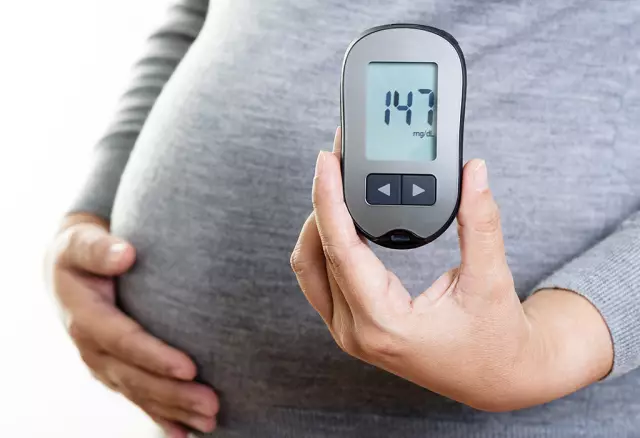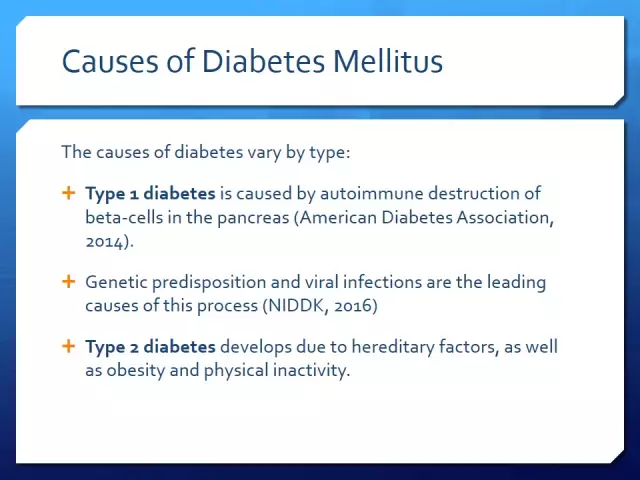- Author Rachel Wainwright [email protected].
- Public 2023-12-15 07:39.
- Last modified 2025-11-02 20:14.
Gestational diabetes mellitus

Nine months after conception is a responsible and stressful period in the life of the expectant mother. A growing fruit requires a lot of energy, trace elements and nutrients. Because of this, pregnancy is a condition that strongly affects a woman's metabolism. One of the manifestations of these changes is gestational insulin resistance.
And the liver, and muscles, and adipose tissue become less sensitive to the pancreatic hormone - insulin. Under unfavorable conditions, this can lead to high blood sugar and the development of diabetes. Diabetes in pregnant women is detected during examination at the antenatal clinic. For analysis for up to 24 weeks, venous blood is taken (sugar or glycated hemoglobin is determined), at a later date, a "sugar curve" is drawn.
Until recently, any newly diagnosed increase in blood sugar during pregnancy was considered gestational diabetes.
Current understanding of gestational diabetes
Currently, there is a Russian national consensus "Gestational diabetes mellitus: diagnosis, treatment, postpartum follow-up." This document is a guide for all physicians, including endocrinologists and obstetricians-gynecologists. According to this guideline, both gestational diabetes mellitus and manifest diabetes can be established in a woman during pregnancy. Moreover, overt diabetes mellitus is diagnosed with higher blood sugar levels. This diagnosis indicates that the increase in sugar is associated not only with pregnancy, and after childbirth, carbohydrate metabolism does not normalize.
Gestational diabetes can be considered a temporary condition and can be expected to improve after the baby is born. Thus, the diagnosis of gestational diabetes is considered more favorable. However, even a slight increase in blood sugar during pregnancy is dangerous for the woman and the fetus. In children whose mothers did not receive sufficient treatment, malformations of internal organs may develop, and a child's weight at birth of more than 4 kg is also very characteristic. A large fetus is at great risk during childbirth. For a woman, gestational diabetes mellitus can be a harbinger of serious disorders of carbohydrate metabolism in the future.
Diagnosis of the disease
Diagnosis is based on symptoms of gestational diabetes mellitus and laboratory findings. The norm is the value of fasting venous blood sugar up to 5.1 mM / L. If blood sugar from a vein falls within the range of 5.1 to 7.0 mM / L, then doctors interpret the results as gestational diabetes. In the event that the result is higher than 7.0 mM / L, then a diagnosis of overt diabetes mellitus is made.
Risk factors for gestational diabetes
The prevalence of gestational diabetes mellitus is growing both in Russia and in the world. The average incidence of the disease is 7%. The most likely increase in blood sugar during pregnancy in women over 30 years of age, overweight and relatives with type 2 diabetes.
Symptoms of gestational diabetes
The increase in blood sugar in this disease is rather insignificant, therefore, pronounced complaints in pregnant women occur quite rarely. Sometimes there is thirst and frequent urination, dry skin. Quite often, a woman develops edema, rapid weight gain, and urinary tract infections.
Treatment of gestational diabetes during pregnancy
A pregnant woman needs regular observation by an obstetrician-gynecologist, therapist or endocrinologist. You should measure your blood sugar daily with a glucometer. The first therapeutic measure is diet. In addition, adequate physical activity (walking, swimming) is immediately recommended. After two weeks, insulin may be added to the treatment. An indication for insulin is persistently high blood sugar. Also, fetal ultrasound data may be the reason for the appointment of insulin. Most often, a pregnant woman is injected with genetically engineered insulin in an intensified mode.
This means that the hormone will be injected multiple times throughout the day. Sugar-lowering pills are strictly prohibited during pregnancy, as they have a negative effect on the fetus. Hospitalization in a hospital for the detection of gestational diabetes is not considered mandatory. There is also no reason to perform a caesarean section or early delivery with this diagnosis without obstetric complications. The main measure for gestational diabetes is diet.
Diet for gestational diabetes

The nutrition of the pregnant woman should be regular and fractional. During the day, you need to eat 4-6 times in small portions. It is important to exclude everything sweet, that is, simple carbohydrates: sucrose, glucose, fructose. These substances raise blood sugar levels the fastest. Of the foods, simple carbohydrates are found in large quantities in all confectionery products. The diet for gestational diabetes involves avoiding honey, fruit juices, bananas, grapes, dried fruits and all sweet foods. In addition to carbohydrates, fats are also limited in the diet, primarily of animal origin. Fats are very high in calories, which means they can increase body weight.
The basis of the diet for gestational diabetes should be vegetables, cereals, low-fat dairy, meat and fish products. Bread should be limited to 50 grams per day. Preference should be given to varieties with the addition of bran or wholemeal flour. Rice, pasta, semolina are best used rarely. Potatoes are preferably boiled, stewed, but not fried. Soups should be in vegetable or low-fat meat broth. Shown to add raw or boiled vegetables to each meal. Salads cannot be seasoned with mayonnaise, sour cream, vegetable oil. During the day, you should not abuse salt, coffee, tea. It is better to minimize canned food, semi-finished products in the diet.
Postpartum care for women with gestational diabetes
Immediately after childbirth, all women with gestational diabetes mellitus are withdrawn insulin, if used. While the patient is in the maternity hospital, her blood sugar is monitored several times. Usually, in the first days after delivery, carbohydrate metabolism is completely normalized. However, the woman will need to be monitored regularly by an endocrinologist at her place of residence. To avoid type 2 diabetes mellitus, it will be necessary to follow a hypocaloric diet in the future, reduce body weight to normal, and expand physical activity.
It is important to control fasting blood sugar or sugar curve 6-12 weeks after delivery. Planning for the next pregnancy should be done in conjunction with an obstetrician and an endocrinologist. A child whose mother suffered from gestational diabetes during pregnancy is also likely to develop disorders of carbohydrate metabolism. Therefore, the pediatrician should be informed about this pregnancy complication.
YouTube video related to the article:
The information is generalized and provided for informational purposes only. At the first sign of illness, see your doctor. Self-medication is hazardous to health!






